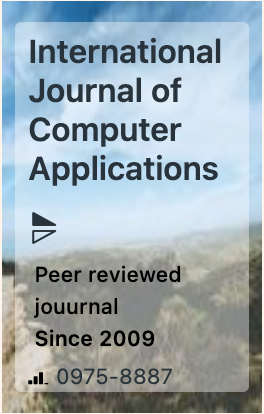The week's pick
Random Articles
Reseach Article
A Hybrid Congestion Detection based Mobility Model for Vehicular Adhoc Networks
| International Journal of Computer Applications |
| Foundation of Computer Science (FCS), NY, USA |
| Volume 187 - Number 11 |
| Year of Publication: 2025 |
| Authors: Rashmi Ranjita, Sasmita Acharya |
 10.5120/ijca2025924675
10.5120/ijca2025924675
|
Rashmi Ranjita, Sasmita Acharya . A Hybrid Congestion Detection based Mobility Model for Vehicular Adhoc Networks. International Journal of Computer Applications. 187, 11 ( Jun 2025), 1-9. DOI=10.5120/ijca2025924675
Abstract
Vehicular Adhoc Network (VANET) is a challenging and growing technology for smart vehicles. It is a network of connected nodes called vehicles. Sharing of information takes place between vehicle to vehicle, vehicle to roadside unit (RSU), RSU to RSU. Various network protocols govern the communication in VANET. Two intensions of VANET are sharing some critical information like road blockage, accidents on road, information about traffic jams etc among vehicles within a particular range and availing entertainment facilities like chatting, toll information, video streaming etc during a journey. Here the communication is either between vehicle to vehicle or between vehicles to infrastructure. It is seen in survey that, due to traffic congestion there is a huge loose of fuel and valuable time. The time spent in traffic congestion can be spent in some productive works. The rapid growing technology of Internet of Things (IoT) made it possible to detect road congestion smartly before it stuck the vehicle in the congestion, so that the vehicle can be diverted in some other route to their destination. This paper proposes two modules one for congestion detection ANFIS based Hybrid Congestion Detection Based Mobility Model (CDMM) that makes aware the vehicle about the congestion on the route and followed by second modified ACO (Ant Colony optimization) module to follow an optimum route to the destination. Also PSO ( Particle Swarm Optimization ) algorithm is implemented to find optimal route to the destination. Both the modified ACO and PSO algorithms are compared to use the best one. After getting information about congestion a vehicle may transfer the same information to other vehicles to prohibit them to enter and get stuck into the jams.
References
- Monika Chibh, Gagandeep Singh and Sahil, Design of Alternate Route Discovery Based on Congestion in Vehicular Network, IEEE Trans Intell Transp SystInternational Journal of Science and Research (IJSR) ISSN (Online):2319-7064.
- Nagaraj S R, Ashwini G, Dr Nalini N, Alternate Path Selection Algorithm By Virtue Of Proactive Congestion Control Technique for VANETS. International Journal of Computer Science Trends and Technology(IJCST) – Volume 3 Issue 2, Mar-Apr 2015.
- Anirudh Paranjothi, Mohammad S Khan, Sherali Zeadally, A Survey on congestion detection and Control in Connected Vehicles. Ad Hoc Networks 108 (2020) 102277.
- Shen Wang, Soufiene Djahel, Jennifer McManis: An Adaptive and VANELs-based Next Road Re-routing System for Unexpected Urban Traffic Congestion Avoidance. http://www.researchgate.net/publication/287205079
- P.E.Hart, N.J.Nilsson and B. Raphael, A formal basis for the heuristic determination of minimum cost paths.System Science and ybernetics, IEEE Transactions on, vol. 4, no. 2, pp-100-107, July 1968
- A. Paranjothi, M. S. Khan, R. Patan, R.M. Parizi, Mohammad Atiquzzaman. VANETomo: A congestion identification and Control Scheme in connected vehicles using network tomography, Computer Communication 151(2020)275-289..
- Sasmita Acharya, C.R. Tripathy, An ANFIS estimator based data aggregation scheme for fault tolerant Wireless Sensor Networks, Journal of King Saud University – Computer and Information Scieneces (2018) 30, 334-348..
- Mohamad Yusof Bin Darus, Kamarulnizam Abu Bakar, Congestion Control Framework for Disseminating Safety Messages in Vehicular AdHoc Networks (VANETs). International Journal of Digital Content Technology and its Applications. Volume 5, Number 2, February 2011 .
- Harjit Singh, Vijay Laxmi, Arun Malik, Isha Batra, Current Research on Congestion Control Schemes in VANET: A Practical Interpretation. International Journal of Recent Technology and Engineering (IJRTE) ISSN: 2277-3878 (Online), Volume-8 Issue-4, November 2019.
- Kamlesh Chandra Purohit, Sanjay Jasola, Enhancing the throughput of a Node by Handling Congestion in VANETS using Efficient Queue Management. https;//doi.org/10.21203/rs.3.rs-531774/v1
- Lokesh M. Giripunje, Abhay Vidyarthi and Shishir Kumar Shandilya, Adaptive Congestion Prediction in Vehicular Ad-hoc Networks (VANET) using Type-2 Fuzzy Model to Establish Reliable Routes. https://doi.org/10.21203/rs.3.rs-458059/v1.
- Jang. J.S.R. and Sun, C.T., (1995), Neuro Fuzzy Modeling and Control. The proceedings of the IEEE, Vol. 83(3),pp.378-406.
- Anita Mohanty 1, Sudipta Mahapatra2, Urmila Bhanja, Traffic Congestion Detection in a city using clustering techniques in VANETs. Indonesian Journal of Electrical Engineering and Computer Science Vol.13, No. 3, March 2019, pp.884-891 ISSN: 2502-4752, DOI:10.11591/ijeecs.v13.i3.pp884-891.
- Alasem, R., M. A., Awan, Mansour, H. ANFIS Based AQM Controller for Congestion Control. International Conference on Advanced Information Networking and Applications 2009.
- Wischhof and H. Rohling, Congestion Control in Vehicular Ad hoc Networks, 2005, pp.5863
- Prakul Singhal and Anamika Yadav, Congestion Detection in Wireless Sensor Network using Neural Network. Conference: 2014 International Conference for Convergence of Technology (12CT). DOI:10.1109/12CT.2014.7092259
- Y. D. Mohamad, et al., Optimizing Congestion Control for Non-safety Messages in VANETs using Taguchi Method, 2017.
- W. Zhang, et al., Optimizing Congestion Control for Safety Messages in VANETs: Concepts and framework. 2008, pp.199-203. DOI:10.1109/ITST.2008.4740256
- C.-L., Huang, et al., Adaptive inter-vehicle communication control for cooperative safety systems. IEEE Network, Vol.24,no.1,pp.6-13,Jan.2010
- Yue Liu, Jun Bi, Ju Yang, Research on Vehicular Ad hoc Networks 2009 IEEE. DOI:10.1109/CCDC.2009.5192343
- Rashmi Ranjita, Sasmita Achanrya, A Fuzzy Logic Based Congestion Detection Technique for Vehicular Adhoc Networks, R. R. Rout et al. (eds.), Advances in Distributed Computing and Machine Learning, Lecture Notes in Networks and Systems, Vol.427, pp.167-177, 2022
- Rashmi Ranjita, Sasmita Acharya, A Fuzzy Logic Based Emergency Vehicle Routing Technique for Vehicular Adhoc Networks, Research Advances in Network Technologies, CRC Press, pp.75-84,2023.\
- M. Subhramaniam et al., A Traffic Density Based Congestion Control Method for VANETs, Hindawi, Wireless Communication and Mobile Computing, Vol-2022, Article ID 7551535, 14 pages, http://doi.org/101155/2022/7551535.
- R.C. Karpagalakshmi et al., An Effective Traffic Management System Using Connected Dominating Set Forwarding (CDSF) Framework for Reducing Traffic Congestion in High Density VANETs, Wireless Personal Communication, https://doi.org/10.1007/s11277-021-08361-y.
- M.R. Jabbarpour et al., Ant-Based Vehicle Congestion Avoidance System Using Vehicular Network, Engineering Applications of Artificial Intelligence 36 (2014) 303-319.
Index Terms
Keywords

